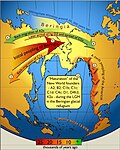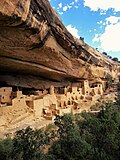Pre-Columbian era
The pre-Columbian era means the history and prehistory of the Americas before there were important European influences on the American continent.
The word pre-Columbian refers to the era before Christopher Columbus, but sometimes it can include the history of American indigenous cultures as they continued to develop after the Christopher Columbus' first landing in 1492, until they were conquered or influenced by Europeans, even if this happened decades or even centuries after the arrival of Columbus.
Pre-Columbian can also mean cultures of any one of the great native civilizations of the Americas, such as those of Mesoamerica (the Aztec and Maya) and of the Andes (Inca, Moche and Chibcha).
Pre-Columbian Era Media
Schematic illustration of maternal (mtDNA) gene-flow in and out of Beringia, from 25,000 years ago to present
Approximate location of the ice-free corridor and specific Paleoindian sites, according to the Clovis theory
Simplified map of subsistence methods in the Americas at 1000 BCE* hunter-gatherers* simple farming societies* complex farming societies (tribal chiefdoms or civilizations)
Artist's reconstruction of Poverty Point, 1500 BCE
Hopewell mounds from the Mound City group in Ohio
The Cliff Palace in Mesa Verde National Park, Colorado.
Related pages
References
- Sorenson, John L. and Johannessen, Carl L. (2006) "Biological Evidence for Pre-Columbian Transoceanic Voyages." In: Contact and Exchange in the Ancient World. Ed. Victor H. Mair. University of Hawai'i Press. pp. 238–297. ISBN 978-0-8248-2884-4
Other websites
- Central Andes Prehistoric Sequence Archived 2010-04-10 at the Wayback Machine









